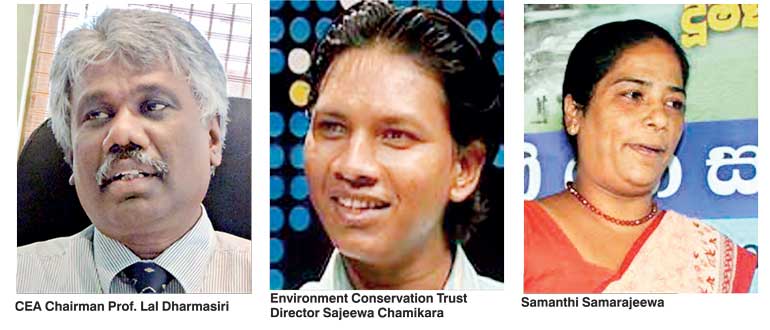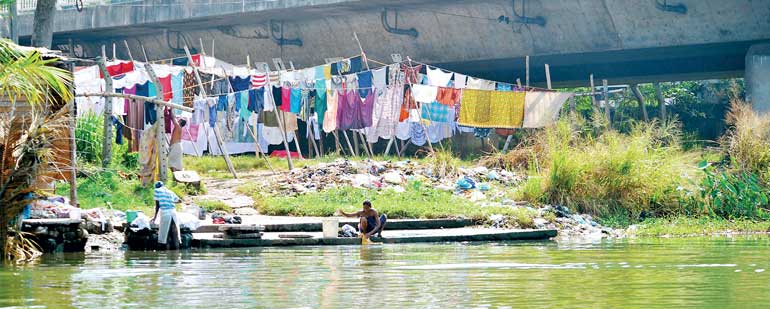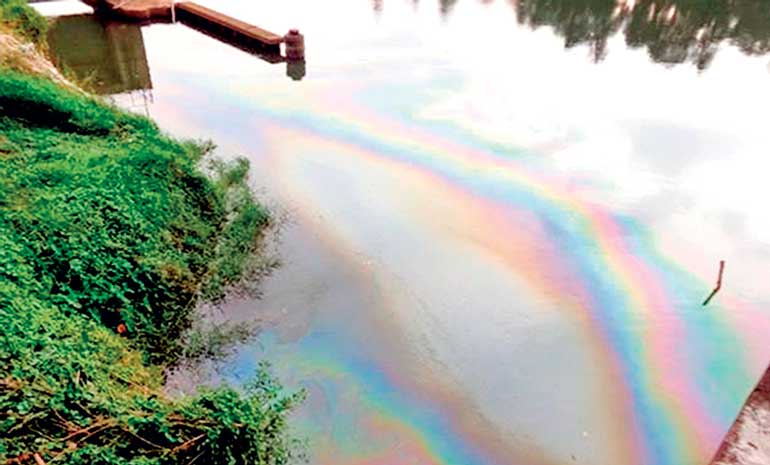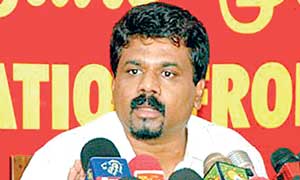Saturday Apr 26, 2025
Saturday Apr 26, 2025
Wednesday, 7 October 2015 00:00 - - {{hitsCtrl.values.hits}}

By Shanika Sriyananda
The Kelani River is an integral part of Samanthi Samarajeewa’s family. Living on the banks of the river, Samanthi and her family which includes two children have a strong bond with the river.
Washing clothes and bathing in the river that runs near her backyard it part of her daily routine. Thinking the river was clean as usual, she recently dipped her clothes in to wash them but soon realised the clothes were soaked in water mixed with sticky oil.
“My friend in the neighbouring house shouted saying not to wash clothes as an oil layer had spread all over the river. It smelled like diesel,” said Samanthi, who lives in Bollegala, Kelaniya, recalling the first day she saw how the Kelani River had been contaminated by an alleged oil leakage from the Coca-Cola Beverages Sri Lanka Ltd. (CCBSL) factory at Biyagama.
She had noticed that fish in the river were jumping up several times due to the strong oil layer in the river water. This resulted in the people of her village panicking and some of them had informed the relevant authorities about the incident.
“The Kelani River has been polluted due to the discharge of industry effluents, sewage and garbage from houses and food waste from hotels,” said Samanthi, who has been using water from the river for bathing and washing for the last 15 years.
She has been able to save some money as their monthly water bill is low since they use water from the river for washing purposes. “I get only a Rs. 180 water bill monthly. If I use only tap water for washing, the bill comes to Rs. 800 per month. My only request to the Government is to take urgent steps to save the river for us,” she said, adding that if the authorities failed to take immediate and appropriate actions to save the Kelani River, it would soon turn into one of the most highly-polluted rivers in the country.

Men washing clothes at a laundry on the banks of the Kelani River
Primary drinking water source
The Kelani River, which starts from Sri Pada and flows to the sea from Modara, poses a grave threat to over 25% of the country’s total population, who depend on it for water requirements, especially for drinking water.
Being the fourth longest river in the country, it is the primary drinking water source for over 80% of the population in the Colombo District.
With a high concentration of chemicals, the Kelani River has become a highly-polluted river, from which people shouldn’t drink water without boiling or purifying it first as it is unhealthy for human consumption.
The recent records of Kelani River water quality indicate that the existing levels of chemicals in water are close to the stipulated high concentration of chemicals.
After the recent incident of the alleged diesel leakage from the Coca-Cola factory into the Kelani River, the laboratory tests done in India had found that the Kelani River was contaminated with cancer-causing chemical 4-methylimidazole.
Residents and eco-group environmentalists claim that Kelani River is mainly polluted due to waste discharge from industries, hotels, service stations and also the excessive use of fertiliser and chemicals in agricultural lands – tea, rubber and home gardens – in the Kelani River basin.
ECT up in arms
Environment Conservation Trust (ECT) Director Sajeewa Chamikara said that the ECT had lodged a complaint with the Human Rights Commission against the Central Environment Authority (CEA), National Water Supply and Drainage Board (NWSDB) and the Biyagama Police for not taking legal action against the Coca-Cola for putting the lives of millions of people, who drank polluted water from the Kelani River, at risk.
“No one is talking about compensating over 600,000 people who drank the contaminated water for over six days due to the oil leakage of the Coca-Cola plant at Biyagama. This is a violation of basic human rights but no State institute is taking the responsibility of punishing the company,” he said.
He said a high percentage of the carcinogenic chemical 4-methylimidazole, which is used to get the caramel shade of the Coca-Cola drink, was found in the tested water.
“If a person uses 29 micrograms of 4-methylimidazole daily, he or she faces a risk of getting a high cancer growth. The water sample tested after the Coca-Cola leakage first by the Indian company revealed there were 0.5 micrograms of 4-methylimidazole per litre. But later, the NWSDB citing another test said there was no 4-methylimidazole chemical but there was grease and oil in water. Why do they have two contradictory test results? We think these State institutes are trying to sweep the truth under the carpet,” Chamikara claimed.
He claimed that there were several charges against the Coca-Cola relating to the toxic leakage that contaminated the Kelani River. “The company can be sued for making over 600,000 water users consume contaminated water for some six days, contaminating the river, polluting drinking water and causing damage to State property by polluting the Ambatale purification plant,” he said.
Chamikara said that the CCBSL has violated the National Environment Act, Water Board Act, Penal Code, and the State Property Act.

An oil layer on the Kelani River
CEA monitoring situation
Meanwhile, CEA Chairman Prof. Lal Dharmasiri said the CEA would frequently monitor the waste disposal of the CCBSL factory in future. “We will also keep a sharp eye on other industries along the Kelani River. There are 67 A grade industries along the river and we have started a special investigation into their waste disposal. We are waiting for the report to resort to taking action in future,” he said.
Commenting on the Coca-Cola incident, Prof. Dharmasiri said that the CEA had taken the right action in line with the legal rights vested within the Authority. “Some segments including environmentalists are accusing us of not taking legal action against the Coca-Cola Company, but we have taken all the measures and will continue to take action within our rules and regulations,” the CEA Chairman said. “If we go to court, in line with the existing fines under the National Environment Act, the maximum punishment imposed on the company is only a fine of Rs. 100,000,” he said, stressing the need of amending the present Act.
CCBSL has already paid Rs. 131 million to the NWSDB, Rs. 1.5 million to the CEA and Rs. 1.7 million to the Marine Pollution Prevention Authority.
He said that the CEA had already made recommendations to the Government to amend the Act and increase the penalty system.
“We are in the process of finalising the recommendations to amend the Act. Under the recommendations, there is no maximum fine for polluting the environment; the court will decide the fine depending on the gravity of the damage,” Prof. Dharmasiri explained.
The CEA will also upgrade its existing laboratory with state-of-art technology to carry out all testing, including for various types of toxic chemicals in water. “At the moment the CEA depends on ITI for laboratory testing but from next year the CEA will have its own laboratory testing facilities to detect any kind of chemicals,” he said.
NWSDB stance
NWSDB General Manager Eng. B.W.R. Balasuriya confirmed that the board had recovered the Rs. 131 million, which was spent on testing, from CCBSL as a fine.
“Taking legal action against CCBSL is the responsibility of the CEA. We have lodged two complaints with the Biyagama Police and also informed the Attorney General’s Department about the incident, but we have no powers under the NWSDB to take legal action against the company,” he explained.
Balasuriya said the NWSDB has taken measures to ensure no floating materials enter the Ambathale water intake by fixing a floating pipe to suck in all unwanted material floating in the river.
He said that the water samples sent to India for scientific testing had found diesel and furnace oil in contaminated water and the board had sent the test results to the CEA for it to submit the laboratory tests as scientific evidence if the CEA was going to take legal action against CCBSL.
Balasuriya said there was no need for consumers to question the quality of pipe-borne water as water taken from the Kelani River was fully purified and checked for all hazardous chemicals before being discharged for consumption by the people.
With the leakage into the Kelani River on 17 August, the NWSDB had stopped supplying water to several areas, including Colombo city limits, Kotte, Sri Jayewardenepura, Dehiwala and Mount Lavinia.
The board had discharged over 200,000 cubic metres of water at the Ambathale purification unit, in which 39 water filters and tanks had to be cleaned due to mixing of diesel and furnace oil in the water.
The spill made the CEA temporarily cancel the Company’s Environmental Protection License but it was re-granted temporarily after CCBSL rectified the damage by implementing the recommendations given by the CEA.
Coca-Cola response
Responding to a public petition, James Quincey, newly-appointed Head of Coca-Cola, has stated: “If there are doubts out there among the general public (about Coca-Cola) whether based on perception or based on reality, then the leader has to stand up.”
The petition said that Coca-Cola must publicly accept responsibility for the contamination of Kelani River water and ensure such incidents do not happen in the future by upgrading its environmental safety measures, while it must also pay compensation for the damage it has caused.
When contacted, CCBSL in a statement said Coca-Cola Company has been in operation in Sri Lanka for over 50 years and had already put in place several measures to prevent such an occurrence in the future. Company sources said that CCBSL wished to reaffirm its commitment to the country and consumers and that the company sincerely regretted the accident.
In a statement, the company said: “We are operating our bottling plant under a conditional license from the CEA. Since the plant has reopened, we have been working in consultation with regulatory bodies so that we can be compliant as per conditions laid out by CEA. We would also like to confirm that we have made all payments to various authorities as advised by the CEA.
“In the early hours of 17 August, our staff noticed a leakage of diesel from a fuel pipeline located within the premises of the company. The leak was plugged immediately by the staff on night duty. However, by the time this leak was plugged, some amount of diesel had escaped into the nearby water body, through the storm water drainage system of the company.
“We informed the local authorities as soon as we noticed it and took corrective and precautionary measures in consultation with them. This includes discontinuing the use of the affected fuel pipeline and temporarily blocking the affected storm water drainage. Services of an independent engineer were obtained to ascertain and verify the effectiveness of the corrective and preventive measures implemented.
“Additionally, we initiated exhaustive preventive actions to avoid any such occurrence in the future. There has been no repetition of any accidental leak since the incident that took place on 17 August and the relevant authorities have physically surveyed and verified the same. As a follow up and in compliance with the directions of the Central Environment Authority (CEA), the CCBSL bottling plant at Biyagama halted its operations beginning 20 August. Earlier, CCBSL had already reimbursed the expenses incurred by the Marine Environment Protection.”
Appeal to save the river
Meanwhile, some residents on the banks of the river speaking on condition of anonymity told the Daily FT that there were many industries, including the Coca-Cola Company, which discharge or dump all their waste – solid and chemical – into the river, but no significant action has been taken against them.
“As villagers living around the river, we are helpless to fight these big companies. Some of the people are workers of these companies and don’t join us to protect the river,” they said.
According to these residents, the river has become a dumping ground for CFL blubs, tyres, polythene, plastic, coconut shells, and all sort of waste and the water along the river banks has a layer of rainbow colours as it is contaminated with various chemicals.
“We don’t know why no authority is keen to carry out a proper study to take stern action against the polluters,” they claimed.
These residents request the Government to implement a proper plan with the coordination of all the authorities and the community to save the river.
By Ashwin Hemmathagama
Our Lobby Correspondent
The contaminant that seeped from the Coca Cola factory in Biyagama bringing the Ambathale water purification complex to a halt on 17 August was not diesel but 4-Methylimisazol, Opposition lawmaker Anura Dissanayake charged in Parliament yesterday.
Charging authorities for allowing the Coca-Cola manufacturer in Sri Lanka to recommence operations despite an ongoing investigation, MP Dissanayake said: “By 17 August 1,900 litres of 4-Methylimisazol had leaked into the Kelani River. The 4-Methylimisazolconcentrate was as high as 0.5mg per water litre as per the test report received based on a sample sent to India.”
Based on the initial investigations conducted suspecting a diesel leak as claimed by the factory, on 20 August the Central Environment Authority banned the permit issued for the operation of the Coca-Cola factory.
“However, on 30 August the Coca-Cola factory was granted permission to commence operations based on the claim it made – a mistake made during a routine maintenance program, which led to fuel leak into the Kelani River. But the villagers claim the factory has been releasing untreated water into the Kelani River all along. There are laws and regulations governing the use of chemicals, cleaning process and releasing of used water back to the environment,” charged MP Dissanayake, demanding to know the reasons for the questionable behaviour of the law enforcement and regulatory authorities, who he charged had been lenient on the multinational fizzy drink maker.
Under Section 23 (2) of the Standing Orders of Parliament, MP Dissanayake demanded the Government name the contaminant found mixed in the Kelani River water samples to confirm if it was 4-Methylimisazol, the total and breakdown of the financial loss borne by State enterprises due to the contamination issue, the value of the compensation received from Coca-Cola and the reasons for discontinuing legal action taken the company, the conditions mentioned in the environment permit issued to Coca-Cola company, and the general procedure to be followed by all factories when releasing water to the Kelani River.
Minister of City Planning and Water Supply Rauff Hakeem will reply Parliament this week.
Discover Kapruka, the leading online shopping platform in Sri Lanka, where you can conveniently send Gifts and Flowers to your loved ones for any event including Valentine ’s Day. Explore a wide range of popular Shopping Categories on Kapruka, including Toys, Groceries, Electronics, Birthday Cakes, Fruits, Chocolates, Flower Bouquets, Clothing, Watches, Lingerie, Gift Sets and Jewellery. Also if you’re interested in selling with Kapruka, Partner Central by Kapruka is the best solution to start with. Moreover, through Kapruka Global Shop, you can also enjoy the convenience of purchasing products from renowned platforms like Amazon and eBay and have them delivered to Sri Lanka.
Discover Kapruka, the leading online shopping platform in Sri Lanka, where you can conveniently send Gifts and Flowers to your loved ones for any event including Valentine ’s Day. Explore a wide range of popular Shopping Categories on Kapruka, including Toys, Groceries, Electronics, Birthday Cakes, Fruits, Chocolates, Flower Bouquets, Clothing, Watches, Lingerie, Gift Sets and Jewellery. Also if you’re interested in selling with Kapruka, Partner Central by Kapruka is the best solution to start with. Moreover, through Kapruka Global Shop, you can also enjoy the convenience of purchasing products from renowned platforms like Amazon and eBay and have them delivered to Sri Lanka.